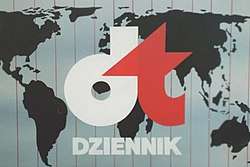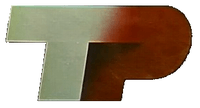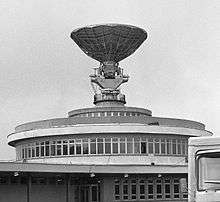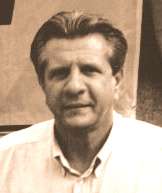Dziennik Telewizyjny
Dziennik Telewizyjny (English: Television Journal; DT), commonly simplified to Dziennik (lit. Journal), was the chief news program of Telewizja Polska between 1958 and 1989, under the communist Polish People's Republic. It was Poland's second regularly televised newscast and the primary propaganda tool used by the Polish United Workers' Party during the Cold War. The final episode aired on 17 November 1989 and the program was replaced by Wiadomości the same year.
| Dziennik Telewizyjny Television Journal | |
|---|---|
 Dziennik logo (1980s) | |
| Also known as | Dziennik, DT, DTV |
| Genre | News program, propaganda |
| Country of origin | Polish People's Republic |
| Original language(s) | Polish |
| Production | |
| Running time | 0:30 minutes (per episode) 0:60 minutes (under martial law; 1981–1983) |
| Release | |
| Original network | Telewizja Polska (State Polish Television) |
| Picture format | 4:3 |
| Original release | 1 January 1958 – 17 November 1989 |
| Chronology | |
| Preceded by | Wiadomości Dnia (1956–1957) |
| Followed by | Wiadomości (1989–) |
Dziennik succeeded a previously run short-term news show on 1 January 1958. Every 30-minute episode was transmitted on the first channel, TVP1, at 08:00 p.m CET (1958–1965) and subsequently at 07:30 p.m CET from 1965 until the fall of communism in 1989. The program was infamous for its propaganda-like theme, manipulative approach, emotive or loaded terms, and extensive political agenda. The broadcast greatly resembled other communist news programs of the period, especially East German Aktuelle Kamera. The show had correspondents who were permanently based in several world cities such as New York, London, Moscow, Paris, and Rome.
The show's 31-year legacy can be seen in Poland today among the older generation, which refers to every contemporary news program as "Dziennik", including newspapers and popular media. At the height of its popularity in the 1970s, Dziennik Telewizyjny was continuously watched by over 11 million people, approximately in every third household in Poland at the time.[1]
History

Background
The origins of Polish television date back to the late 1930s when numerous tests were carried out on top of the Warsaw Prudential building to transmit monochrome images at a 20-kilometer radius.[2][3] However, the beginning of World War II interrupted further attempts at establishing regular receivers. The prime state television corporation, the Telewizja Polska, was founded after the war in 1952.[4] The foundation date corresponds to the time of the very first regularly televised broadcast which occurred at 07:00 p.m CET on 25 October 1952.[4] Initially, the auditions were broadcast to a limited number of viewers and at set dates, often a month apart. On 23 January 1953 regular shows began to appear on the first and only channel, TVP1.[5] Snippets of world and domestic events was given only spontaneously and at various times by different people. Most reliable sources of information in the 1950s were newspapers, most notably Trybuna Ludu (People's Tribune).
The first newscast was short-lived Wiadomości Dnia, which aired on 30 April 1956 and lasted until the end of 1957.[6] The first televised weather forecast also appeared on 4 September 1957. The Polish United Workers' Party and the Polish Politburo announced that Dziennik Telewizyjny, a government-controlled news program, will begin on 1 January 1958. The abbreviation for the program was "DTV" until the late 1970s (when it was shortened to just "DT"), but the show became widely known as the Dziennik (English: Journal) to the general public for the next three decades. The 55 km-range signal antenna in the shape of a butterfly was situated on the spire of the Palace of Culture and Science in Warsaw, at an altitude of 227 meters.[6] The antenna also appeared on the call sign ident (identification screen and logo) at the beginning of every broadcast until 1972.

Schedule and timing
Each main episode or edition of the program was originally transmitted at 08:00 p.m and starting from 1965 at 7:30 p.m. CET. Telewizja Polska continues to emit its contemporary flagship news show, Wiadomości, at 7:30 p.m. to this day.[7]
With the development of Polish television, other related spin-offs and side shows accompanying the Dziennik were introduced. On 2 October 1970 the second channel, TVP2, was launched.[8] From 1965 until 1976, the evening edition of Dziennik was replaced by Monitor, which was presented by Karol Małcużyński and Edmund Męclewski. On 26 June 1986, a second but shorter and more direct newsflash called Teleexpress aired on TVP1.[9] Since 30 March 1987, a third program also showing snippets, Panorama, began airing on TVP2 as an alternative to Teleexpress.[10]
Under martial law in Poland, from December 1981 Dziennik was presented by officers of the Polish Armed Forces or newsreaders in military uniforms and broadcast 24-hours a day.[11][12] The running time has also been extended to 60 minutes. The program returned to its original form in 1983.[13]
The first coloured episode of Dziennik was transmitted on 6 December 1971.[14]
The final telecast aired on 17 November 1989.
Controversies and legacy
The program was highly controversial throughout its existence as it did not report news that could trigger anti-government sentiment. Furthermore, the communist authorities of the Polish People's Republic and the Polish United Workers' Party used it for its propaganda aimed at manipulating the audience. Similar newscasts used for identical purposes were present in all countries of the Eastern Bloc, most infamous being Aktuelle Kamera from the German Democratic Republic and Vremya from the Soviet Union.[15]
Dziennik was known to be strikingly objective about world affairs and, almost in every case, each episode featured a coverage from foreign countries where corruption, war and scandals were abundant. The goal was to minimize the effects of the issues that were occurring in Poland at the time, such as the 1968 Polish political crisis, 1970 protests, June 1976 protests and the near-bankruptcy of the Polish People's Republic in the 1980s. The newsreaders often used emotive and loaded text with a pro-government and pro-socialist bias. The tone also used was very formal, serious and at times nostalgic, particularly during national holidays. The anchors rarely smiled and addressed guests or referred to people as obywatelu ("citizen", equivalent to comrade in other communist states) instead of Pan/Pani (Sir/Mrs) – T–V distinction.
On 28 October 1989, actress Joanna Szczepkowska was invited to the studio to discuss her theatrical career. Instead, she asked the host if she could deliver a message to the viewers. After being granted permission Szczepkowska stated "Ladies and Gentlemen. On 4 June 1989 communism has ended in Poland".[16][17] This occurred shortly after Tadeusz Mazowiecki was elected as the first non-communist Prime Minister of Poland. The situation was unusual as the TV anchor agreed to Szczepkowska's message on a communist-funded program, which glorified Marxism-Leninism and socialism for decades.[17] The message was broadcast to millions across the country and became symbolic of the period of transition to democracy.[18]
Numerous epigrams and jokes about Dziennik surfaced in the 1980s; one suggesting that "the only factual aspect of the show was the date". Satirist Jacek Fedorowicz also parodied the program in the 1990s, often recalling the most infamous texts and lines from Dziennik.[19]
In contemporary Poland, the older generation tends to name every news program "Dziennik", regardless of the station or channel. The word "Dziennik" can also be synonymous with terms like propaganda and disinformation, especially when referring to televised news.
Notable newsreaders

|
1970s:
|
1980s:
|
Bibliography
- "30 lat temu wyemitowano ostatnie wydanie Dziennika Telewizyjnego". wiadomosci.dziennik.pl. November 17, 2019.
- "80 lat temu wyemitowano pierwszy w Polsce oficjalny program telewizyjny". www.tvp.info.
- "Zapomniany jubileusz TVP". Newsweek.pl.
- "Symboliczny początek Telewizji Polskiej. Te 30 minut powojenne pokolenie wspomina z łezką w oku". naTemat.pl.
- S.A, Wirtualna Polska Media (October 23, 2007). "55. rocznica pierwszej audycji Telewizji Polskiej". wiadomosci.wp.pl.
- "Polska telewizja ma 50 lat". Onet Wiadomości. April 30, 2006.
- "Dziennik Telewizyjny". www.irekw.internetdsl.pl.
- "1970: Startuje TVP2". warszawa.wyborcza.pl.
- "Historia programu". teleexpress.tvp.pl.
- "O nas". panorama.tvp.pl.
- S.A, Wirtualna Polska Media (December 11, 2013). "Dziennikarze w mundurach - Propaganda w stanie wojennym". wiadomosci.wp.pl.
- "Gwiazda stanu wojennego pracował jako nocny stróż". www.tvp.info.
- "Wyborcza.pl". wyborcza.pl.
- S.A, Wirtualna Polska Media (December 5, 2013). "Pierwszy kolorowy program telewizyjny w Polsce". opinie.wp.pl.
- Mihelj, Sabina; Huxtable, Simon (August 23, 2018). "From Media Systems to Media Cultures: Understanding Socialist Television". Cambridge University Press – via Google Books.
- http://www.slupsk.pl/wp-content/uploads/2019/06/Nasza_Wolnosc_ZOFIA-DANIELKIEWICZ.pdf
- ""4 czerwca 1989 roku skończył się w Polsce komunizm". Przypominamy, co 29 lat temu działo się w kraju". gazetapl.
- "Szczepkowska ogłasza koniec PRL". tygodnik.tvp.pl.
- ""Znam się na manipulowaniu". Fedorowicz znów zrobił "Dziennik Telewizyjny", ale nie wyemitowałby go w TVP". naTemat.pl.